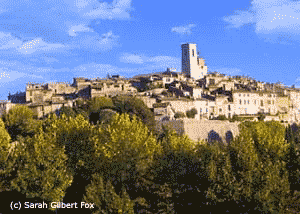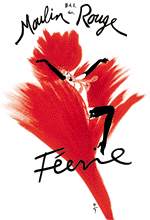Saint-Paul de Vence & Beyond

- SUBSCRIBE
- ALREADY SUBSCRIBED?
BECOME A BONJOUR PARIS MEMBER
Gain full access to our collection of over 5,000 articles and bring the City of Light into your life. Just 60 USD per year.
Find out why you should become a member here.
Sign in
Fill in your credentials below.
Nestled behind Cannes and the fabled French Rivera, and surrounded by a  cliff-like circle is the tiny cluster of closely-knit buildings called Saint-Paul de Vence. Tucked in back of ancient ramparts it sits, like a huge boat, perched on a mountaintop looking out over the azure Mediterranean. With its proximity to the sunny “Cote d’Azur” (the region from Saint Tropez to Nice and the Italian frontier), artists such as Braque, Miró and Picabia were joined by French and Hollywood royalty like Cole Porter, Yves Montand, Simone Signoret, Burt Lancaster, Kirk Douglas, Carlo Ponti and Sophia Loren, to name but a few, found an ideal playground.
cliff-like circle is the tiny cluster of closely-knit buildings called Saint-Paul de Vence. Tucked in back of ancient ramparts it sits, like a huge boat, perched on a mountaintop looking out over the azure Mediterranean. With its proximity to the sunny “Cote d’Azur” (the region from Saint Tropez to Nice and the Italian frontier), artists such as Braque, Miró and Picabia were joined by French and Hollywood royalty like Cole Porter, Yves Montand, Simone Signoret, Burt Lancaster, Kirk Douglas, Carlo Ponti and Sophia Loren, to name but a few, found an ideal playground.
Once you enter this sun-baked valley, located only 12 km from Nice, you will discover why idyllic Saint-Paul was such a Mecca of artists of all types, and why so many worked, relaxed and entertained at the Colombe d’Or. Lovers of modern art and connoisseurs of old Europe will be delighted by what they discover.
The Colombe d’Or is an intimate inn made up of sixteen rooms and ten suites. In 1931, Paul Roux and his beautiful wife, Titine transformed the building, which now feels like a comfortable museum, from an old club. In exchange for food, they accepted works of art by both fast rising or little-known painters like Modigliani, Chaim Soutine, Pierre Bonnard and Signac. Their creations grace the property: a ceramic mosaic mural by Leger on the dining terrace features powerful nudes and a dove that dominates the wall; his rendition of the magical sprawling bird can be seen from the pool.
At the water’s edge, a Calder statue seems to move with the breeze. Even the guest book provided a canvas, and boasts drawings by Picasso, Miró and others (often highlighting the hotel’s dove theme). There is even a small drawing by Charlie Chaplin. In the cave-like bar there are photographs of Picasso, David Niven, Donald Sutherland and other stars that have called the Colombe d’Or home. All lend themselves to the atmosphere of old-world glamour.
While one could spend their days basking in the luxury of the Colombe d’Or, the ancient medieval town itself is charming (and filled to capacity with tourists for much of the year), with narrow cobbled streets, seventeenth-century fountains, and fascinating galleries and crafts shops. The modern but simple Foundation  Maeght (pronounced Megg) was named for the Dutch collectors who started the museum. Visitors can walk in a magical walled garden containing statues by Arp, murals by Miró and cane-like masterpieces by Giacometti, Calder, Dufy and Dubuffet; the water-generated, moveable statues are amazing. There is a second level from which the viewer can look down upon some of the statues. From here, the vista is lovely.
Maeght (pronounced Megg) was named for the Dutch collectors who started the museum. Visitors can walk in a magical walled garden containing statues by Arp, murals by Miró and cane-like masterpieces by Giacometti, Calder, Dufy and Dubuffet; the water-generated, moveable statues are amazing. There is a second level from which the viewer can look down upon some of the statues. From here, the vista is lovely.
In neighboring Vence, surrounded by olive groves, Matisse lived and redesigned a tiny chapel (After a near-death experience in the 1940s, sister Jacques-Marie nursed him back to health. He offered to redesign the nearby church as thanks for her efforts). Today, thousands visit the little Chapelle du Rosaire des Dominicaines de Vence (“Chapel of the Rosary”), which Matisse considered his masterpiece, to see the stained glass windows of blue and yellow, a simple pulpit and drawings of the Stations of the Cross.
The city of Nice is home to the wonderful museums of Matisse and Chagall. The Marc Chagall Museum contains more than a dozen magisterial canvases featuring great scenes of the Old Testament. Set in a beautiful residential corner of Nice, high above the sea, one can walk amongst the paintings, murals, stained glass windows, sketches and pieces of sculpture within the modern building’s walls. There are also Roman ruins close by.
Located in an expansive park-like setting is the Matisse Museum. In a restored structure, the viewer is treated to a collection of Matisse’s masterpieces (as well as works from the his early life). Here, fauvism (paintings based on a movement begun in 1905 which was known by its vivid use of color) comes breathtakingly alive as only a master could achieve. Likewise, even the black sketches show the genius of the well-loved painter and provide a feast for the eyes. Don’t miss it.
Picasso is featured in nearby Antibes (16 km from Saint-Paul) where the ancient and imposing Grimaldi chateau has been converted into a museum. Within these glorious walls, Picasso honed his craft by working in ceramics, an art he came to master; there is also a large collection of several important paintings here. His homes in La Californie, Cap d’Antibes or Mougins and Vallauris became a refuge for him, both during his prime working years, and in the last years of his life. He now rests in the garden at Vauvenargues near Aix-en-Provence, in the shadow of Cézanne’s mountain.
The villages in the South of France offer artistic delights and a stay at the fabled Hotel Colombe d’Or will be memorable. Its popularity and small size make advance reservations a must. Even if you simply go for a meal, the experience will be rewarding. Call in advance. Hotel Colombe d’Or, 1 Place du Général-de-Gaulle, St-Paul-de-Vence, tel: 04 93 32 80 02, fax: 04 93 32 77 78, www.la-colombe-dor.com. Closed in November and December; double rooms begin at €260.


